Analysis of Fluid Volume Deficit and Acute Pain: A Case Study
VerifiedAdded on 2023/06/13
|12
|2387
|312
Case Study
AI Summary
This case study focuses on Mr. Ron Fraser, addressing fluid volume deficit (hypovolemia) and acute pain. The analysis includes abnormal cues, contributing factors like inadequate fluid intake and low blood pressure, and physiological responses related to colon cancer and diabetes. Nursing interventions are outlined with SMART outcome criteria, including fluid management through medication and lifestyle changes to address hypotension, and emotional support to reduce stress and pain. The study references various sources to support the diagnoses, goals, nursing actions, and rationales for patient care.

Name of patient: Mr Ron Fraser
Scenario 2B - Fluid volume deficit (Hypovolaemia) and Acute Pain
List the clusters of abnormal cues related to the above priority problems in the identified scenario situation. Provide the normal value or range for each with
an in-text reference
Abnormal cues relevant to fluid
status
Abnormal cues relevant to pain Normal value Reference (in-text only)
Respiratory rate Due to increase in pain it increases
individual pain.
12 to 16 breath per minutes (de Carvalho and et. al., 2020)
Low blood pressure (hypotension) Pain and dehydration, emotional stress 120/80 (Warren and et. al., 2019)
High pain score High pain score 0 means no pain, 1-3 mild pain, 4-7
moderate pain, 8 and more is severe
pain.
(Zeidman and et. al., 2021)
Less urine output Obstruction or blockage leads to body
pain which is a symptoms and lead to
decreases in urine output.
Normal range 1.5 to 2 ml/kg/hour (Turkington and et. al., 2019)
Feeling nauseated and not able to drink
sips of water.
Abdominal pain and cramps due to less
drinking of water can occur.
590 to 740 ml per hour (Puri and et. al., 2020)
Haemo-serous drainage in belovac 300 to 500 ml thick. (Devnani and et. al., 2020)
Oxygen saturation 93% 95% (Vesoulis and et. al., 2022)
Scenario 2B - Fluid volume deficit (Hypovolaemia) and Acute Pain
List the clusters of abnormal cues related to the above priority problems in the identified scenario situation. Provide the normal value or range for each with
an in-text reference
Abnormal cues relevant to fluid
status
Abnormal cues relevant to pain Normal value Reference (in-text only)
Respiratory rate Due to increase in pain it increases
individual pain.
12 to 16 breath per minutes (de Carvalho and et. al., 2020)
Low blood pressure (hypotension) Pain and dehydration, emotional stress 120/80 (Warren and et. al., 2019)
High pain score High pain score 0 means no pain, 1-3 mild pain, 4-7
moderate pain, 8 and more is severe
pain.
(Zeidman and et. al., 2021)
Less urine output Obstruction or blockage leads to body
pain which is a symptoms and lead to
decreases in urine output.
Normal range 1.5 to 2 ml/kg/hour (Turkington and et. al., 2019)
Feeling nauseated and not able to drink
sips of water.
Abdominal pain and cramps due to less
drinking of water can occur.
590 to 740 ml per hour (Puri and et. al., 2020)
Haemo-serous drainage in belovac 300 to 500 ml thick. (Devnani and et. al., 2020)
Oxygen saturation 93% 95% (Vesoulis and et. al., 2022)
Paraphrase This Document
Need a fresh take? Get an instant paraphrase of this document with our AI Paraphraser
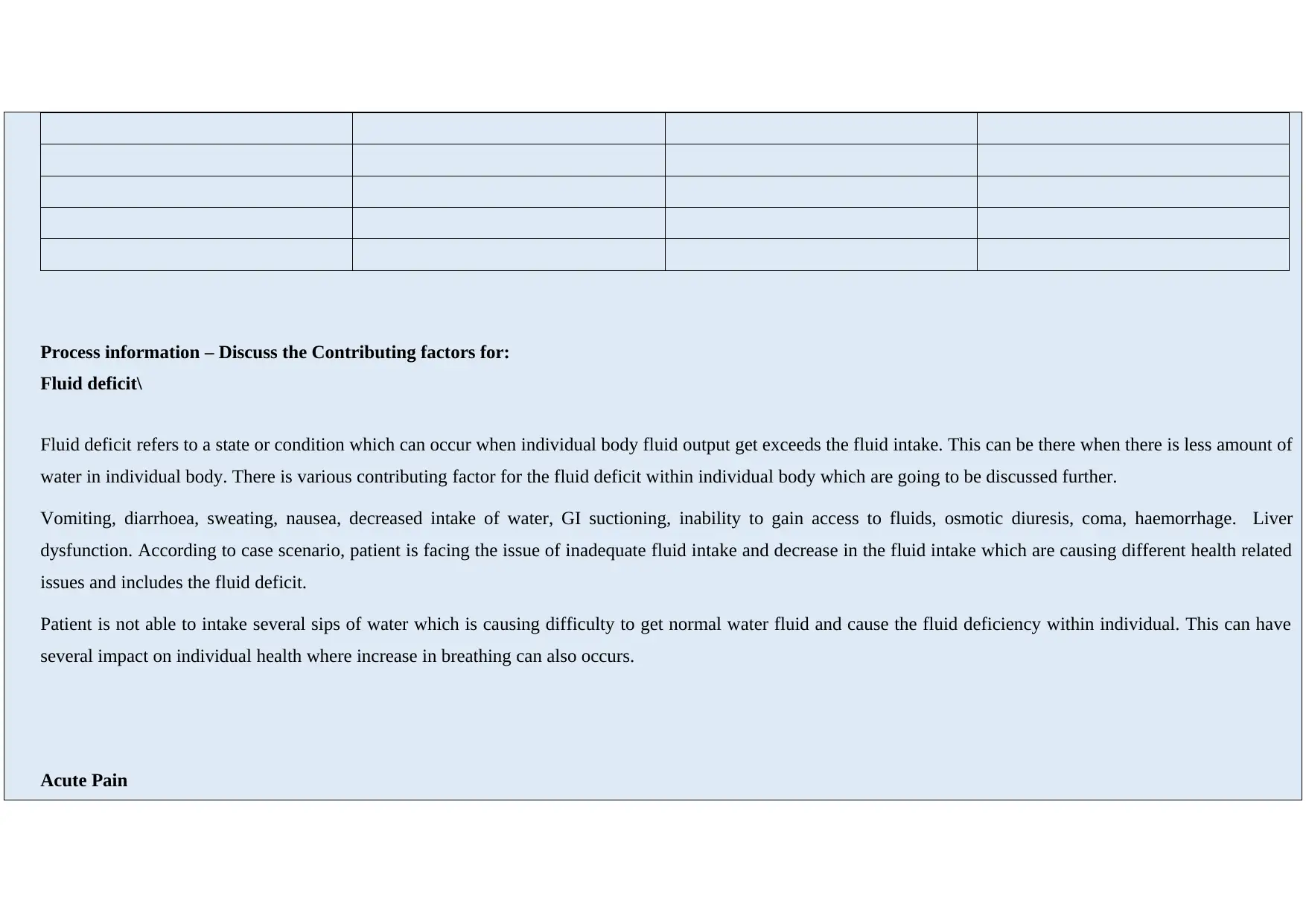
Process information – Discuss the Contributing factors for:
Fluid deficit\
Fluid deficit refers to a state or condition which can occur when individual body fluid output get exceeds the fluid intake. This can be there when there is less amount of
water in individual body. There is various contributing factor for the fluid deficit within individual body which are going to be discussed further.
Vomiting, diarrhoea, sweating, nausea, decreased intake of water, GI suctioning, inability to gain access to fluids, osmotic diuresis, coma, haemorrhage. Liver
dysfunction. According to case scenario, patient is facing the issue of inadequate fluid intake and decrease in the fluid intake which are causing different health related
issues and includes the fluid deficit.
Patient is not able to intake several sips of water which is causing difficulty to get normal water fluid and cause the fluid deficiency within individual. This can have
several impact on individual health where increase in breathing can also occurs.
Acute Pain
Fluid deficit\
Fluid deficit refers to a state or condition which can occur when individual body fluid output get exceeds the fluid intake. This can be there when there is less amount of
water in individual body. There is various contributing factor for the fluid deficit within individual body which are going to be discussed further.
Vomiting, diarrhoea, sweating, nausea, decreased intake of water, GI suctioning, inability to gain access to fluids, osmotic diuresis, coma, haemorrhage. Liver
dysfunction. According to case scenario, patient is facing the issue of inadequate fluid intake and decrease in the fluid intake which are causing different health related
issues and includes the fluid deficit.
Patient is not able to intake several sips of water which is causing difficulty to get normal water fluid and cause the fluid deficiency within individual. This can have
several impact on individual health where increase in breathing can also occurs.
Acute Pain

There is various risk factor which are leading to cause the acute pain within patient. This may include the low blood pressure or hypotension which is one of the main
cause which are causing acute pain. Due to not taking proper intake of fluid create the issue of low blood pressure which also leads to cause pain within individual
patient.
Due to lower uptake of water and electrolyte leads to create the risk of getting lower blood pressure which also leads to carry on the hypotension and cause pain to
individual.
Slightly distended abdomen is also cause pain which occurs due to bloating of gas, which can be either due to accumulated fluid, digestive content of tissues. It can also
lead to chronic or acute.
Due to less oxygen saturation also leads to create an impact on individual which cause stress and difficulty in intake of oxygen and needed supplementary support. Due
to deficiency in intake of oxygen can also cause some pain which can play and important factor of acute pain.
Process information – Discuss physiological responses associated with the problems and link these to the presenting symptom (cues).
Fluid deficit: As per the case scenario of Mr. Fraser, the cancer in the colon generally begin when the healthy cells within the lining of the rectum and colon can alter
as well as grow out of control, and can forming a collective mass is known as tumor. In this, a tumor may be cancerous or benign. the cancerous tumor is generally
malignant, meaning it can increase as well as spread towards the other organs or parts of the human body. in addition to this, there are the environmental factors or the
genetic factors which can cause the colorectal cancer do so by simply promoting the acquisition of the mark behaviours of the cancer in the epithelial cells of colon. in
context with Mr. Fraser’s case, he was a heavy smoker and drink alcohol in moderations. such that people who smoke can effectively develop the wide as well as many
colon polyps. it is identified that the risk of improving cancer of colon from smoking is as elevated as the people with colon cancer. the patients can develop a cancer of
colon if they are having absence of daily physical activities, reduced healthy diets, obesity and overweight, consumption of alcohol, consuming high diet food
cause which are causing acute pain. Due to not taking proper intake of fluid create the issue of low blood pressure which also leads to cause pain within individual
patient.
Due to lower uptake of water and electrolyte leads to create the risk of getting lower blood pressure which also leads to carry on the hypotension and cause pain to
individual.
Slightly distended abdomen is also cause pain which occurs due to bloating of gas, which can be either due to accumulated fluid, digestive content of tissues. It can also
lead to chronic or acute.
Due to less oxygen saturation also leads to create an impact on individual which cause stress and difficulty in intake of oxygen and needed supplementary support. Due
to deficiency in intake of oxygen can also cause some pain which can play and important factor of acute pain.
Process information – Discuss physiological responses associated with the problems and link these to the presenting symptom (cues).
Fluid deficit: As per the case scenario of Mr. Fraser, the cancer in the colon generally begin when the healthy cells within the lining of the rectum and colon can alter
as well as grow out of control, and can forming a collective mass is known as tumor. In this, a tumor may be cancerous or benign. the cancerous tumor is generally
malignant, meaning it can increase as well as spread towards the other organs or parts of the human body. in addition to this, there are the environmental factors or the
genetic factors which can cause the colorectal cancer do so by simply promoting the acquisition of the mark behaviours of the cancer in the epithelial cells of colon. in
context with Mr. Fraser’s case, he was a heavy smoker and drink alcohol in moderations. such that people who smoke can effectively develop the wide as well as many
colon polyps. it is identified that the risk of improving cancer of colon from smoking is as elevated as the people with colon cancer. the patients can develop a cancer of
colon if they are having absence of daily physical activities, reduced healthy diets, obesity and overweight, consumption of alcohol, consuming high diet food
⊘ This is a preview!⊘
Do you want full access?
Subscribe today to unlock all pages.

Trusted by 1+ million students worldwide
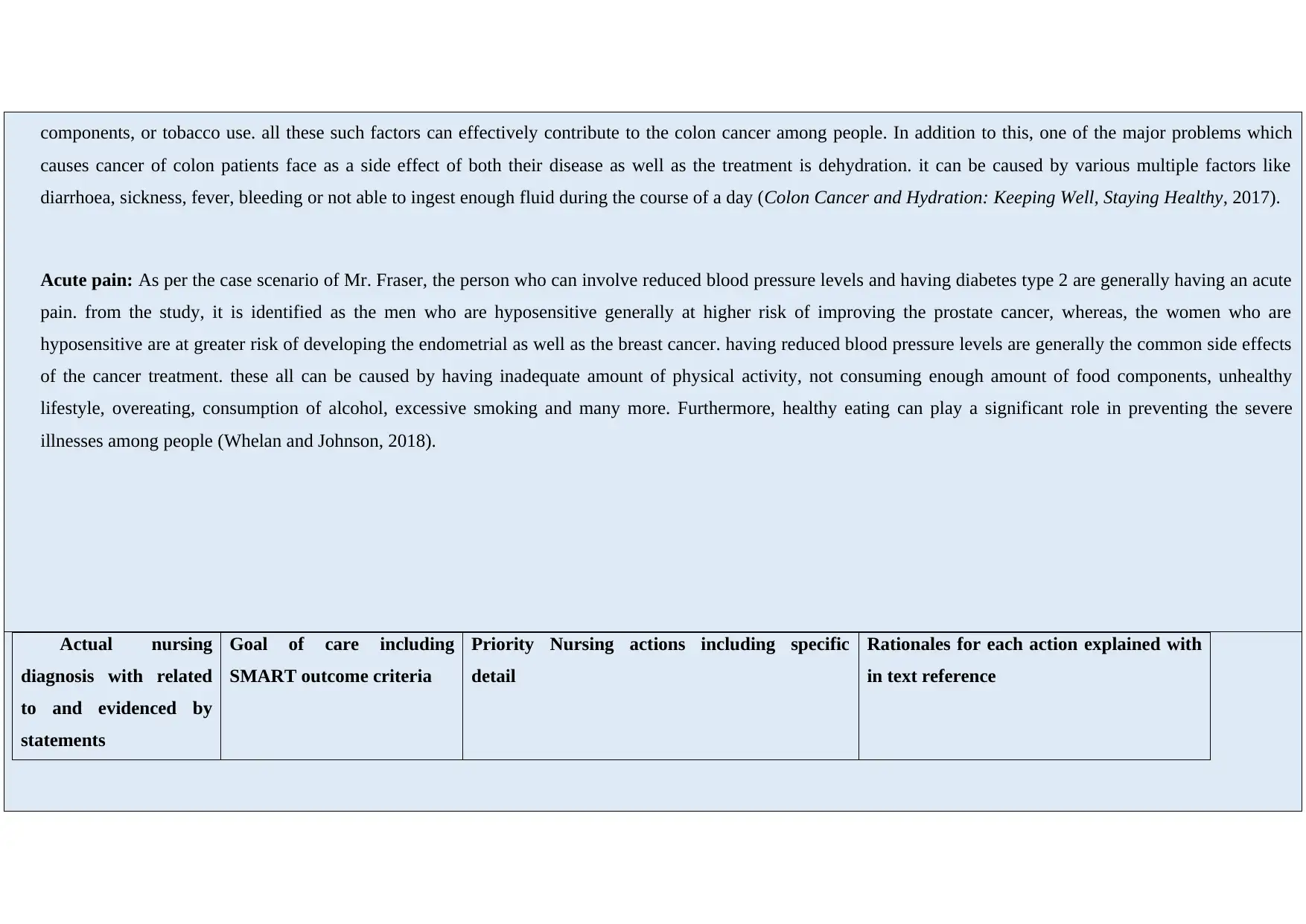
components, or tobacco use. all these such factors can effectively contribute to the colon cancer among people. In addition to this, one of the major problems which
causes cancer of colon patients face as a side effect of both their disease as well as the treatment is dehydration. it can be caused by various multiple factors like
diarrhoea, sickness, fever, bleeding or not able to ingest enough fluid during the course of a day (Colon Cancer and Hydration: Keeping Well, Staying Healthy, 2017).
Acute pain: As per the case scenario of Mr. Fraser, the person who can involve reduced blood pressure levels and having diabetes type 2 are generally having an acute
pain. from the study, it is identified as the men who are hyposensitive generally at higher risk of improving the prostate cancer, whereas, the women who are
hyposensitive are at greater risk of developing the endometrial as well as the breast cancer. having reduced blood pressure levels are generally the common side effects
of the cancer treatment. these all can be caused by having inadequate amount of physical activity, not consuming enough amount of food components, unhealthy
lifestyle, overeating, consumption of alcohol, excessive smoking and many more. Furthermore, healthy eating can play a significant role in preventing the severe
illnesses among people (Whelan and Johnson, 2018).
Actual nursing
diagnosis with related
to and evidenced by
statements
Goal of care including
SMART outcome criteria
Priority Nursing actions including specific
detail
Rationales for each action explained with
in text reference
causes cancer of colon patients face as a side effect of both their disease as well as the treatment is dehydration. it can be caused by various multiple factors like
diarrhoea, sickness, fever, bleeding or not able to ingest enough fluid during the course of a day (Colon Cancer and Hydration: Keeping Well, Staying Healthy, 2017).
Acute pain: As per the case scenario of Mr. Fraser, the person who can involve reduced blood pressure levels and having diabetes type 2 are generally having an acute
pain. from the study, it is identified as the men who are hyposensitive generally at higher risk of improving the prostate cancer, whereas, the women who are
hyposensitive are at greater risk of developing the endometrial as well as the breast cancer. having reduced blood pressure levels are generally the common side effects
of the cancer treatment. these all can be caused by having inadequate amount of physical activity, not consuming enough amount of food components, unhealthy
lifestyle, overeating, consumption of alcohol, excessive smoking and many more. Furthermore, healthy eating can play a significant role in preventing the severe
illnesses among people (Whelan and Johnson, 2018).
Actual nursing
diagnosis with related
to and evidenced by
statements
Goal of care including
SMART outcome criteria
Priority Nursing actions including specific
detail
Rationales for each action explained with
in text reference
Paraphrase This Document
Need a fresh take? Get an instant paraphrase of this document with our AI Paraphraser

Fluid volume deficit
(Hypovolaemia)
Related to:
The patients who are
having fluid volume
deficit can involve
compliant with weakness
as well as thirst which
can or cannot be
accompanied by
tachycardia or weak
pulse rates. patients can
involve weight loss
depending over the
severity of the fluid
volume deficit,
concentrated urine output
or the reduced urine
output. as per the case
scenario, Mr. Fraser is
having reduced urine
To provide management
related with adnominal pain
through ensuring medication
at proper time and monitoring
to reduce the reducing in
body fluid within 1 day.
The nursing interventions in order to reduce the
hypotension such as alteration in lifestyle. the care
nurses can suggest the changes in the lifestyle,
containing drinking enough amount of water,
avoiding alcohol, and many more. the patients
who are having low blood levels can use more salt
amount in their food, wear the compression
stocking such that elastic stockings are more
commonly used to relieve the swelling and pain of
the veins can effectively aid to decrease the
pooling of blood within legs. the care nurses can
also provide medications that can be effectively
used to treat the hypotension such as
Flurocortisone can effectively encourage the blood
to raise its volume. the physicians can often use
the medication midodrine in order to increase the
blood pressure levels within people having
hypotension.
It is acknowledged by providing effective
care actions to Mr. Fraser that he can able to
overcome his conditions such as
hypotension. by prescribing him effective
medications and advices of consuming more
salt can help him to reduce his illness
effectively ( Abdelhafiz, 2022).
(Hypovolaemia)
Related to:
The patients who are
having fluid volume
deficit can involve
compliant with weakness
as well as thirst which
can or cannot be
accompanied by
tachycardia or weak
pulse rates. patients can
involve weight loss
depending over the
severity of the fluid
volume deficit,
concentrated urine output
or the reduced urine
output. as per the case
scenario, Mr. Fraser is
having reduced urine
To provide management
related with adnominal pain
through ensuring medication
at proper time and monitoring
to reduce the reducing in
body fluid within 1 day.
The nursing interventions in order to reduce the
hypotension such as alteration in lifestyle. the care
nurses can suggest the changes in the lifestyle,
containing drinking enough amount of water,
avoiding alcohol, and many more. the patients
who are having low blood levels can use more salt
amount in their food, wear the compression
stocking such that elastic stockings are more
commonly used to relieve the swelling and pain of
the veins can effectively aid to decrease the
pooling of blood within legs. the care nurses can
also provide medications that can be effectively
used to treat the hypotension such as
Flurocortisone can effectively encourage the blood
to raise its volume. the physicians can often use
the medication midodrine in order to increase the
blood pressure levels within people having
hypotension.
It is acknowledged by providing effective
care actions to Mr. Fraser that he can able to
overcome his conditions such as
hypotension. by prescribing him effective
medications and advices of consuming more
salt can help him to reduce his illness
effectively ( Abdelhafiz, 2022).
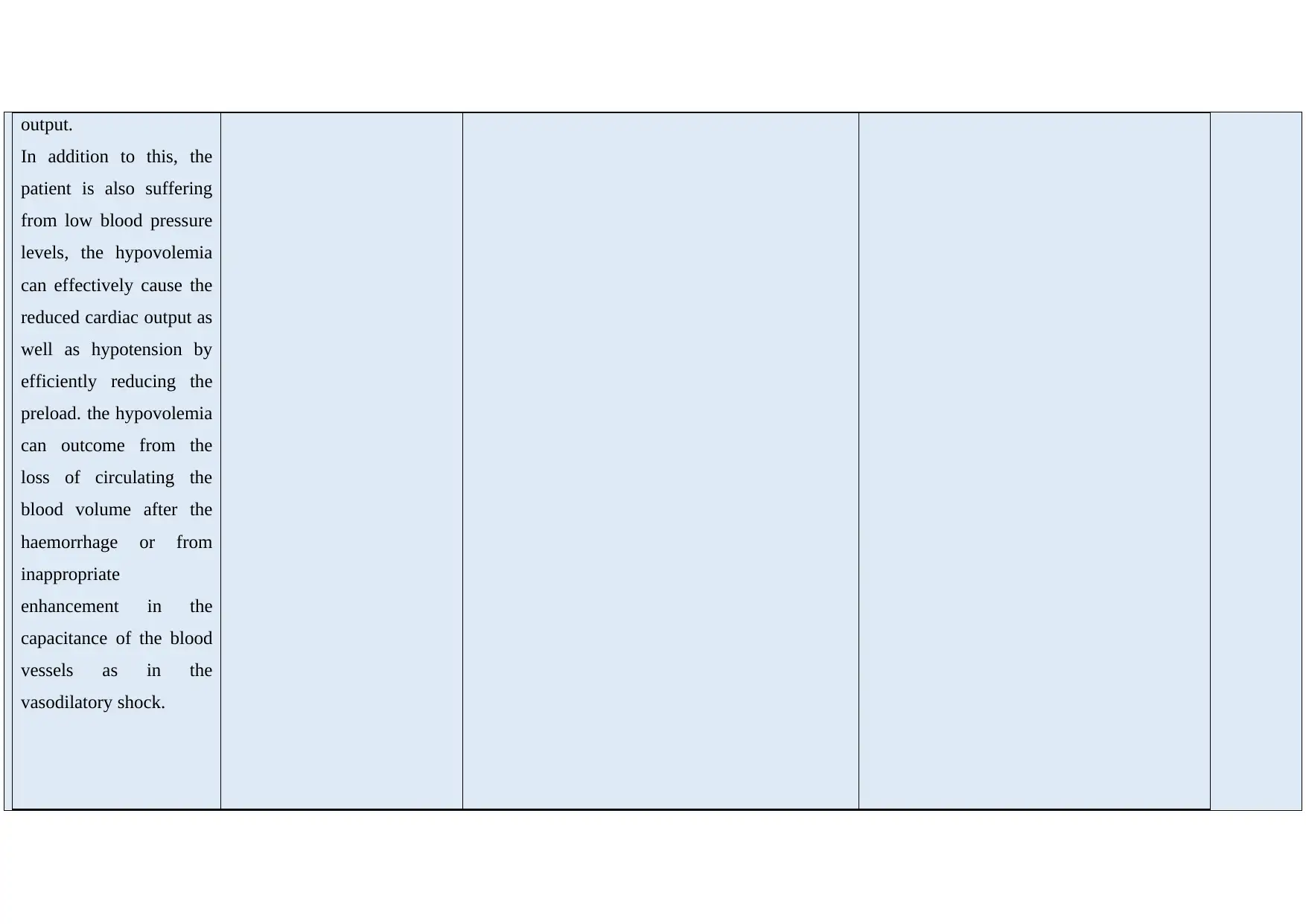
output.
In addition to this, the
patient is also suffering
from low blood pressure
levels, the hypovolemia
can effectively cause the
reduced cardiac output as
well as hypotension by
efficiently reducing the
preload. the hypovolemia
can outcome from the
loss of circulating the
blood volume after the
haemorrhage or from
inappropriate
enhancement in the
capacitance of the blood
vessels as in the
vasodilatory shock.
In addition to this, the
patient is also suffering
from low blood pressure
levels, the hypovolemia
can effectively cause the
reduced cardiac output as
well as hypotension by
efficiently reducing the
preload. the hypovolemia
can outcome from the
loss of circulating the
blood volume after the
haemorrhage or from
inappropriate
enhancement in the
capacitance of the blood
vessels as in the
vasodilatory shock.
⊘ This is a preview!⊘
Do you want full access?
Subscribe today to unlock all pages.

Trusted by 1+ million students worldwide
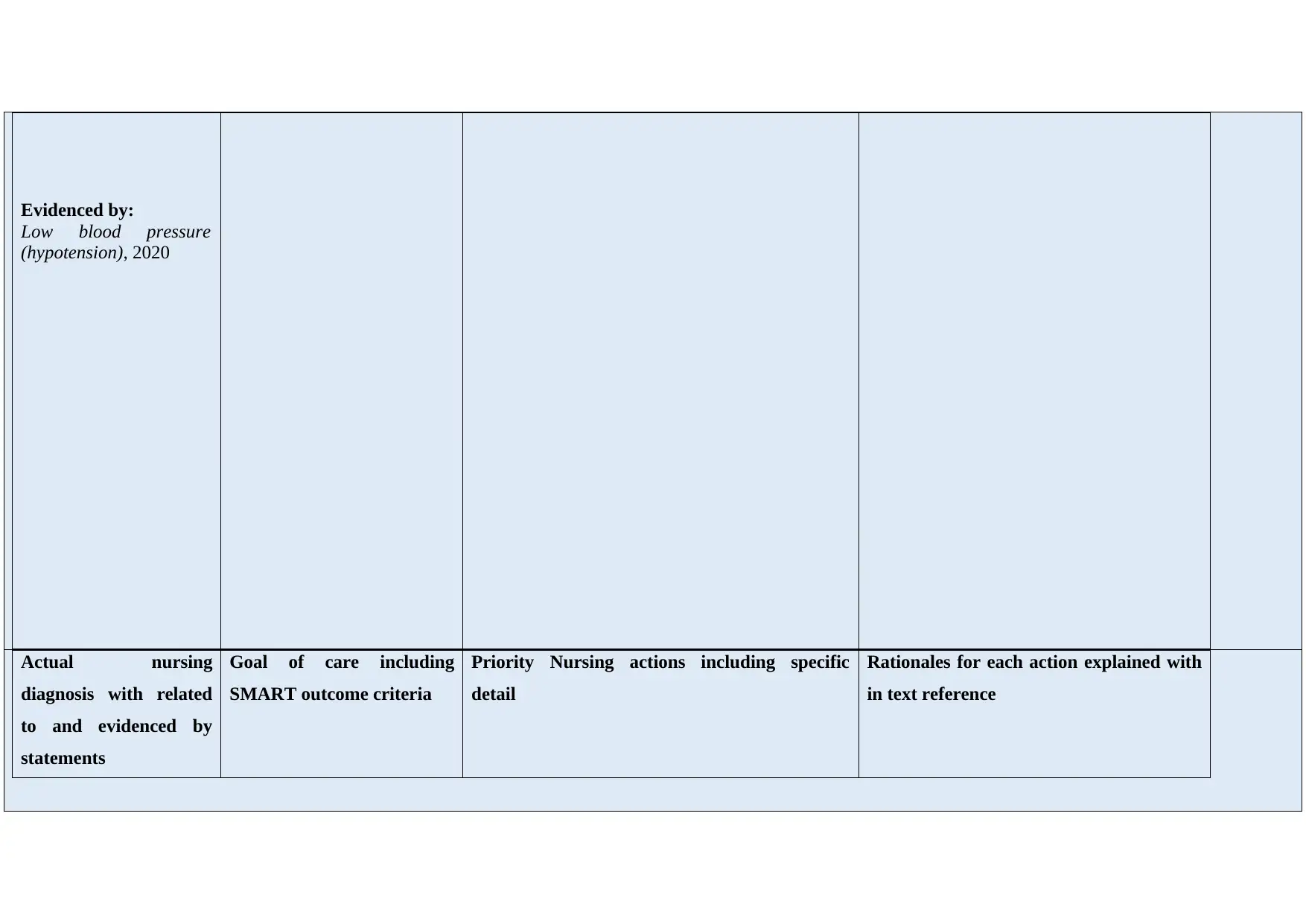
Evidenced by:
Low blood pressure
(hypotension), 2020
Actual nursing
diagnosis with related
to and evidenced by
statements
Goal of care including
SMART outcome criteria
Priority Nursing actions including specific
detail
Rationales for each action explained with
in text reference
Low blood pressure
(hypotension), 2020
Actual nursing
diagnosis with related
to and evidenced by
statements
Goal of care including
SMART outcome criteria
Priority Nursing actions including specific
detail
Rationales for each action explained with
in text reference
Paraphrase This Document
Need a fresh take? Get an instant paraphrase of this document with our AI Paraphraser
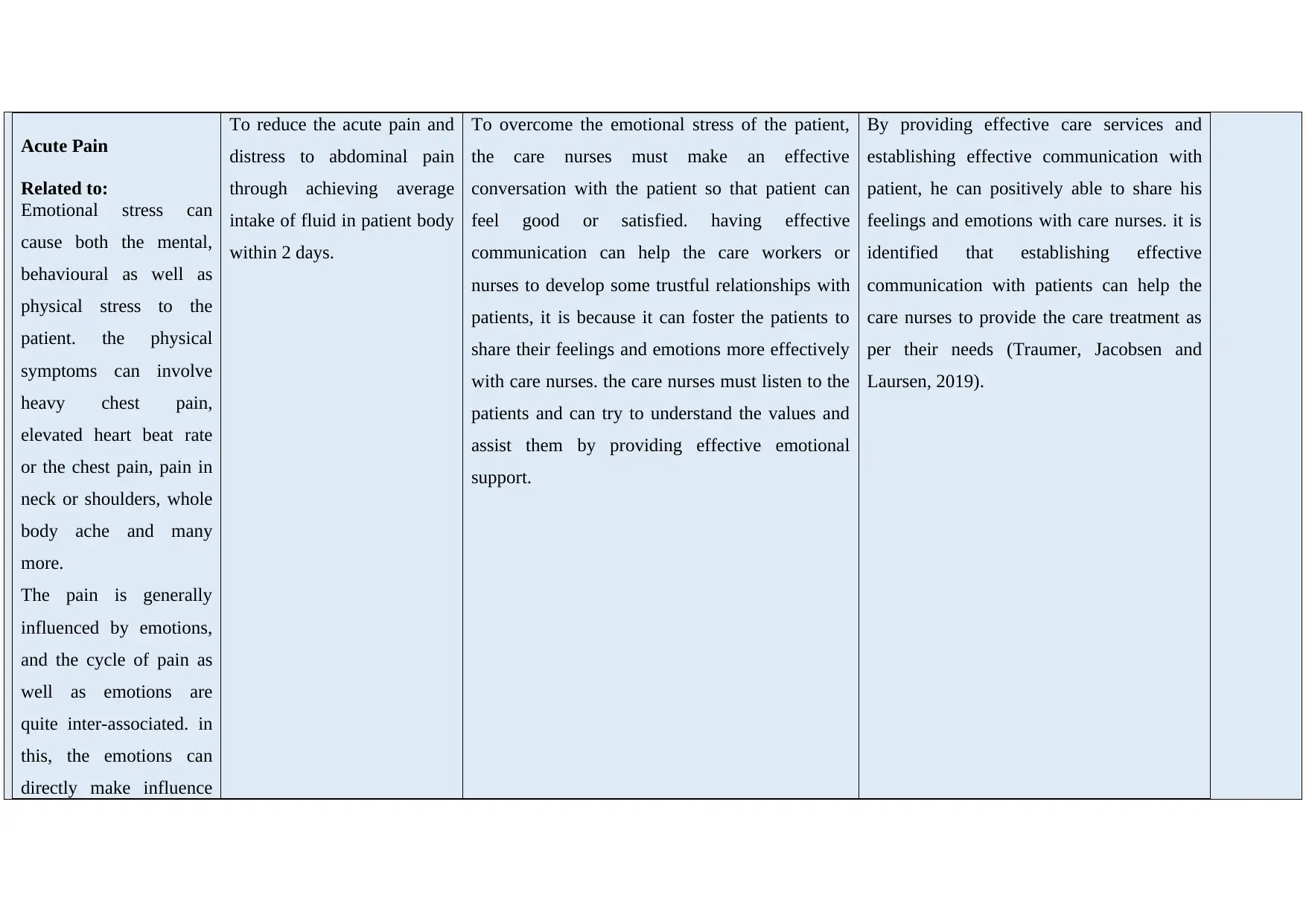
Acute Pain
Related to:
Emotional stress can
cause both the mental,
behavioural as well as
physical stress to the
patient. the physical
symptoms can involve
heavy chest pain,
elevated heart beat rate
or the chest pain, pain in
neck or shoulders, whole
body ache and many
more.
The pain is generally
influenced by emotions,
and the cycle of pain as
well as emotions are
quite inter-associated. in
this, the emotions can
directly make influence
To reduce the acute pain and
distress to abdominal pain
through achieving average
intake of fluid in patient body
within 2 days.
To overcome the emotional stress of the patient,
the care nurses must make an effective
conversation with the patient so that patient can
feel good or satisfied. having effective
communication can help the care workers or
nurses to develop some trustful relationships with
patients, it is because it can foster the patients to
share their feelings and emotions more effectively
with care nurses. the care nurses must listen to the
patients and can try to understand the values and
assist them by providing effective emotional
support.
By providing effective care services and
establishing effective communication with
patient, he can positively able to share his
feelings and emotions with care nurses. it is
identified that establishing effective
communication with patients can help the
care nurses to provide the care treatment as
per their needs (Traumer, Jacobsen and
Laursen, 2019).
Related to:
Emotional stress can
cause both the mental,
behavioural as well as
physical stress to the
patient. the physical
symptoms can involve
heavy chest pain,
elevated heart beat rate
or the chest pain, pain in
neck or shoulders, whole
body ache and many
more.
The pain is generally
influenced by emotions,
and the cycle of pain as
well as emotions are
quite inter-associated. in
this, the emotions can
directly make influence
To reduce the acute pain and
distress to abdominal pain
through achieving average
intake of fluid in patient body
within 2 days.
To overcome the emotional stress of the patient,
the care nurses must make an effective
conversation with the patient so that patient can
feel good or satisfied. having effective
communication can help the care workers or
nurses to develop some trustful relationships with
patients, it is because it can foster the patients to
share their feelings and emotions more effectively
with care nurses. the care nurses must listen to the
patients and can try to understand the values and
assist them by providing effective emotional
support.
By providing effective care services and
establishing effective communication with
patient, he can positively able to share his
feelings and emotions with care nurses. it is
identified that establishing effective
communication with patients can help the
care nurses to provide the care treatment as
per their needs (Traumer, Jacobsen and
Laursen, 2019).
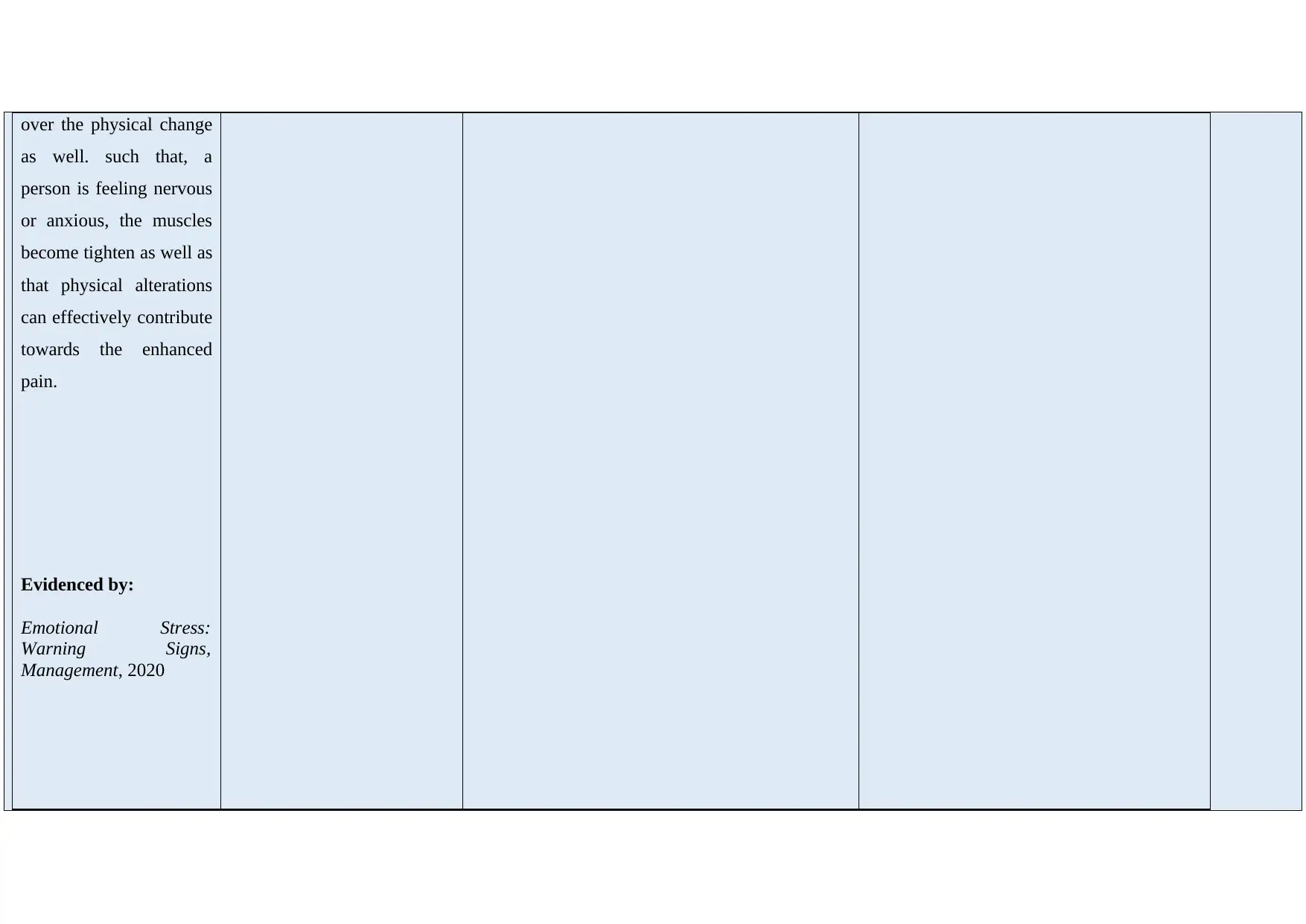
over the physical change
as well. such that, a
person is feeling nervous
or anxious, the muscles
become tighten as well as
that physical alterations
can effectively contribute
towards the enhanced
pain.
Evidenced by:
Emotional Stress:
Warning Signs,
Management, 2020
as well. such that, a
person is feeling nervous
or anxious, the muscles
become tighten as well as
that physical alterations
can effectively contribute
towards the enhanced
pain.
Evidenced by:
Emotional Stress:
Warning Signs,
Management, 2020
⊘ This is a preview!⊘
Do you want full access?
Subscribe today to unlock all pages.

Trusted by 1+ million students worldwide
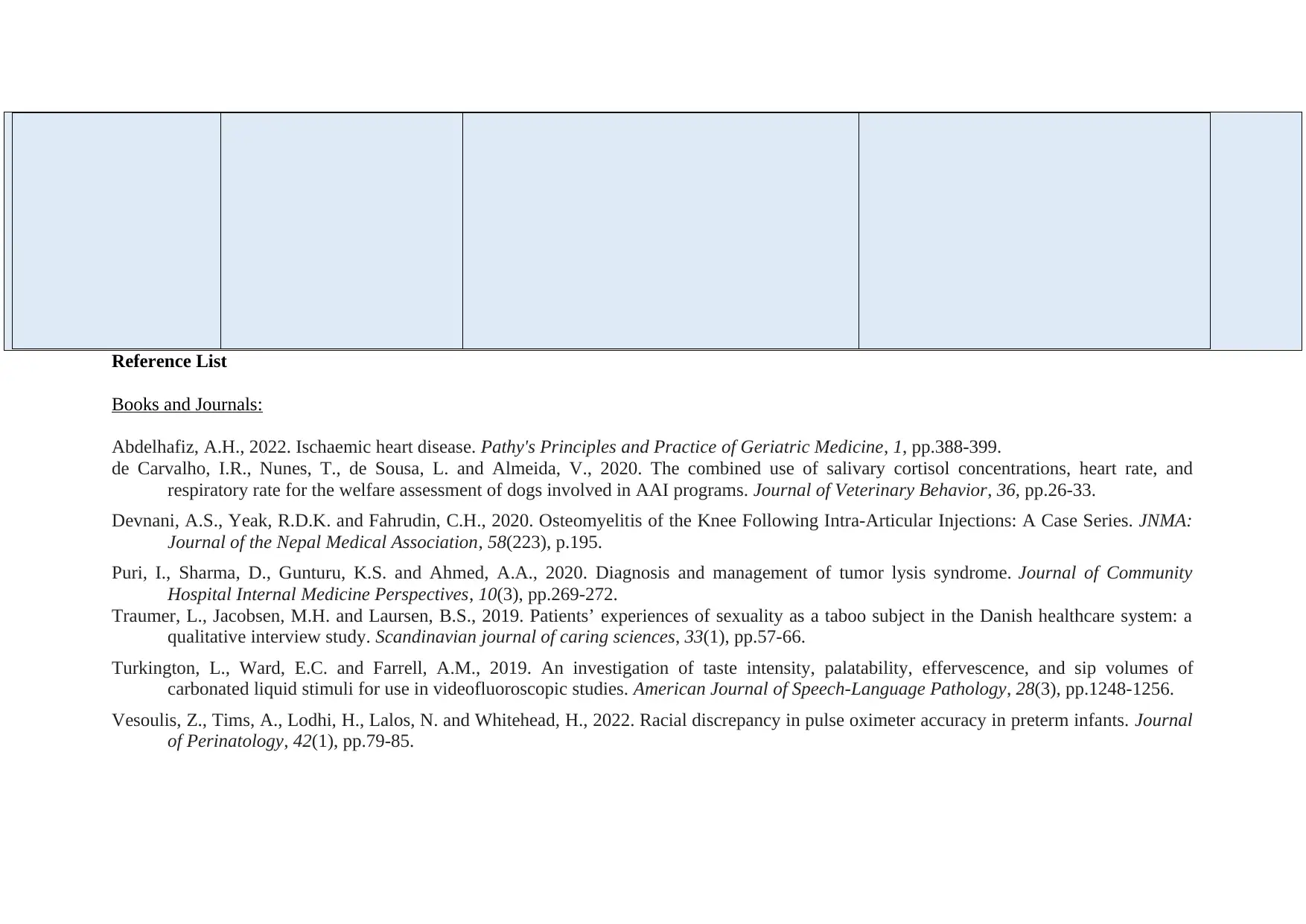
Reference List
Books and Journals:
Abdelhafiz, A.H., 2022. Ischaemic heart disease. Pathy's Principles and Practice of Geriatric Medicine, 1, pp.388-399.
de Carvalho, I.R., Nunes, T., de Sousa, L. and Almeida, V., 2020. The combined use of salivary cortisol concentrations, heart rate, and
respiratory rate for the welfare assessment of dogs involved in AAI programs. Journal of Veterinary Behavior, 36, pp.26-33.
Devnani, A.S., Yeak, R.D.K. and Fahrudin, C.H., 2020. Osteomyelitis of the Knee Following Intra-Articular Injections: A Case Series. JNMA:
Journal of the Nepal Medical Association, 58(223), p.195.
Puri, I., Sharma, D., Gunturu, K.S. and Ahmed, A.A., 2020. Diagnosis and management of tumor lysis syndrome. Journal of Community
Hospital Internal Medicine Perspectives, 10(3), pp.269-272.
Traumer, L., Jacobsen, M.H. and Laursen, B.S., 2019. Patients’ experiences of sexuality as a taboo subject in the Danish healthcare system: a
qualitative interview study. Scandinavian journal of caring sciences, 33(1), pp.57-66.
Turkington, L., Ward, E.C. and Farrell, A.M., 2019. An investigation of taste intensity, palatability, effervescence, and sip volumes of
carbonated liquid stimuli for use in videofluoroscopic studies. American Journal of Speech-Language Pathology, 28(3), pp.1248-1256.
Vesoulis, Z., Tims, A., Lodhi, H., Lalos, N. and Whitehead, H., 2022. Racial discrepancy in pulse oximeter accuracy in preterm infants. Journal
of Perinatology, 42(1), pp.79-85.
Books and Journals:
Abdelhafiz, A.H., 2022. Ischaemic heart disease. Pathy's Principles and Practice of Geriatric Medicine, 1, pp.388-399.
de Carvalho, I.R., Nunes, T., de Sousa, L. and Almeida, V., 2020. The combined use of salivary cortisol concentrations, heart rate, and
respiratory rate for the welfare assessment of dogs involved in AAI programs. Journal of Veterinary Behavior, 36, pp.26-33.
Devnani, A.S., Yeak, R.D.K. and Fahrudin, C.H., 2020. Osteomyelitis of the Knee Following Intra-Articular Injections: A Case Series. JNMA:
Journal of the Nepal Medical Association, 58(223), p.195.
Puri, I., Sharma, D., Gunturu, K.S. and Ahmed, A.A., 2020. Diagnosis and management of tumor lysis syndrome. Journal of Community
Hospital Internal Medicine Perspectives, 10(3), pp.269-272.
Traumer, L., Jacobsen, M.H. and Laursen, B.S., 2019. Patients’ experiences of sexuality as a taboo subject in the Danish healthcare system: a
qualitative interview study. Scandinavian journal of caring sciences, 33(1), pp.57-66.
Turkington, L., Ward, E.C. and Farrell, A.M., 2019. An investigation of taste intensity, palatability, effervescence, and sip volumes of
carbonated liquid stimuli for use in videofluoroscopic studies. American Journal of Speech-Language Pathology, 28(3), pp.1248-1256.
Vesoulis, Z., Tims, A., Lodhi, H., Lalos, N. and Whitehead, H., 2022. Racial discrepancy in pulse oximeter accuracy in preterm infants. Journal
of Perinatology, 42(1), pp.79-85.
Paraphrase This Document
Need a fresh take? Get an instant paraphrase of this document with our AI Paraphraser
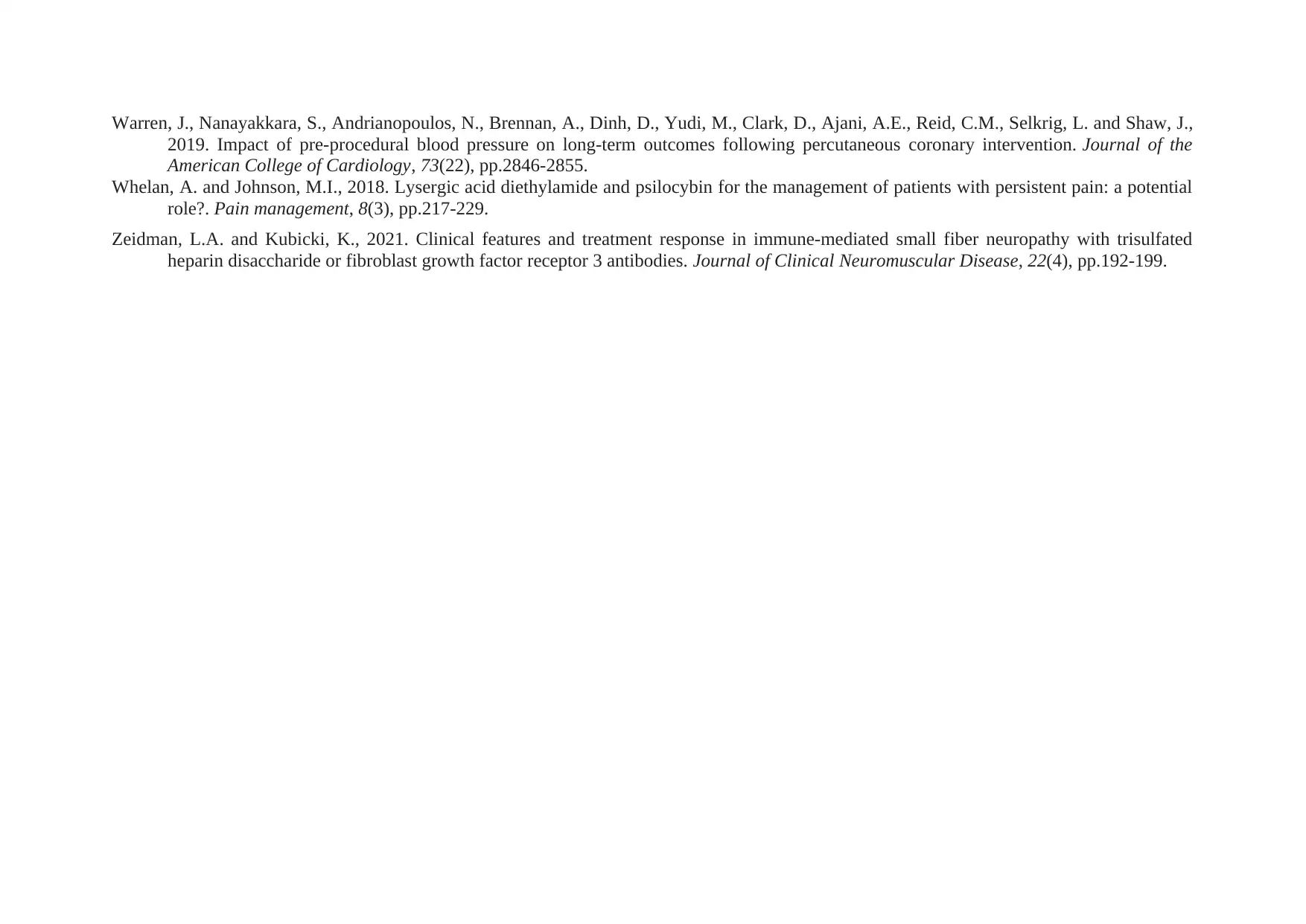
Warren, J., Nanayakkara, S., Andrianopoulos, N., Brennan, A., Dinh, D., Yudi, M., Clark, D., Ajani, A.E., Reid, C.M., Selkrig, L. and Shaw, J.,
2019. Impact of pre-procedural blood pressure on long-term outcomes following percutaneous coronary intervention. Journal of the
American College of Cardiology, 73(22), pp.2846-2855.
Whelan, A. and Johnson, M.I., 2018. Lysergic acid diethylamide and psilocybin for the management of patients with persistent pain: a potential
role?. Pain management, 8(3), pp.217-229.
Zeidman, L.A. and Kubicki, K., 2021. Clinical features and treatment response in immune-mediated small fiber neuropathy with trisulfated
heparin disaccharide or fibroblast growth factor receptor 3 antibodies. Journal of Clinical Neuromuscular Disease, 22(4), pp.192-199.
2019. Impact of pre-procedural blood pressure on long-term outcomes following percutaneous coronary intervention. Journal of the
American College of Cardiology, 73(22), pp.2846-2855.
Whelan, A. and Johnson, M.I., 2018. Lysergic acid diethylamide and psilocybin for the management of patients with persistent pain: a potential
role?. Pain management, 8(3), pp.217-229.
Zeidman, L.A. and Kubicki, K., 2021. Clinical features and treatment response in immune-mediated small fiber neuropathy with trisulfated
heparin disaccharide or fibroblast growth factor receptor 3 antibodies. Journal of Clinical Neuromuscular Disease, 22(4), pp.192-199.
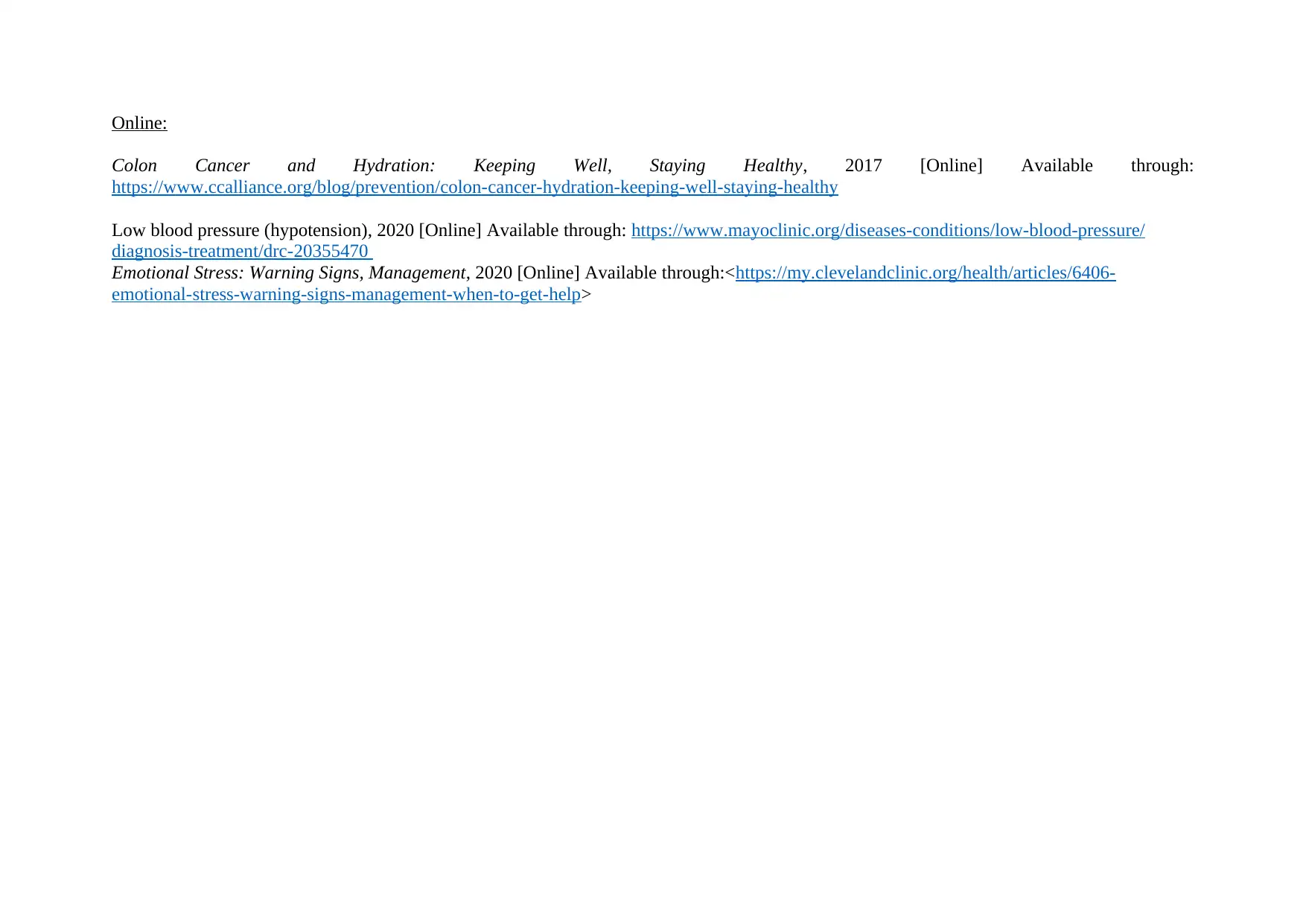
Online:
Colon Cancer and Hydration: Keeping Well, Staying Healthy, 2017 [Online] Available through:
https://www.ccalliance.org/blog/prevention/colon-cancer-hydration-keeping-well-staying-healthy
Low blood pressure (hypotension), 2020 [Online] Available through: https://www.mayoclinic.org/diseases-conditions/low-blood-pressure/
diagnosis-treatment/drc-20355470
Emotional Stress: Warning Signs, Management, 2020 [Online] Available through:<https://my.clevelandclinic.org/health/articles/6406-
emotional-stress-warning-signs-management-when-to-get-help>
Colon Cancer and Hydration: Keeping Well, Staying Healthy, 2017 [Online] Available through:
https://www.ccalliance.org/blog/prevention/colon-cancer-hydration-keeping-well-staying-healthy
Low blood pressure (hypotension), 2020 [Online] Available through: https://www.mayoclinic.org/diseases-conditions/low-blood-pressure/
diagnosis-treatment/drc-20355470
Emotional Stress: Warning Signs, Management, 2020 [Online] Available through:<https://my.clevelandclinic.org/health/articles/6406-
emotional-stress-warning-signs-management-when-to-get-help>
⊘ This is a preview!⊘
Do you want full access?
Subscribe today to unlock all pages.

Trusted by 1+ million students worldwide
1 out of 12
Related Documents
Your All-in-One AI-Powered Toolkit for Academic Success.
+13062052269
info@desklib.com
Available 24*7 on WhatsApp / Email
![[object Object]](/_next/static/media/star-bottom.7253800d.svg)
Unlock your academic potential
Copyright © 2020–2025 A2Z Services. All Rights Reserved. Developed and managed by ZUCOL.





